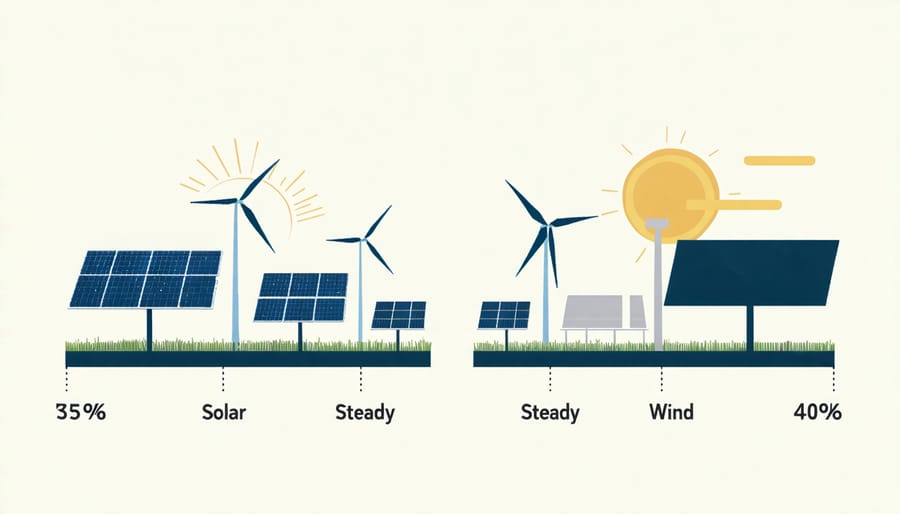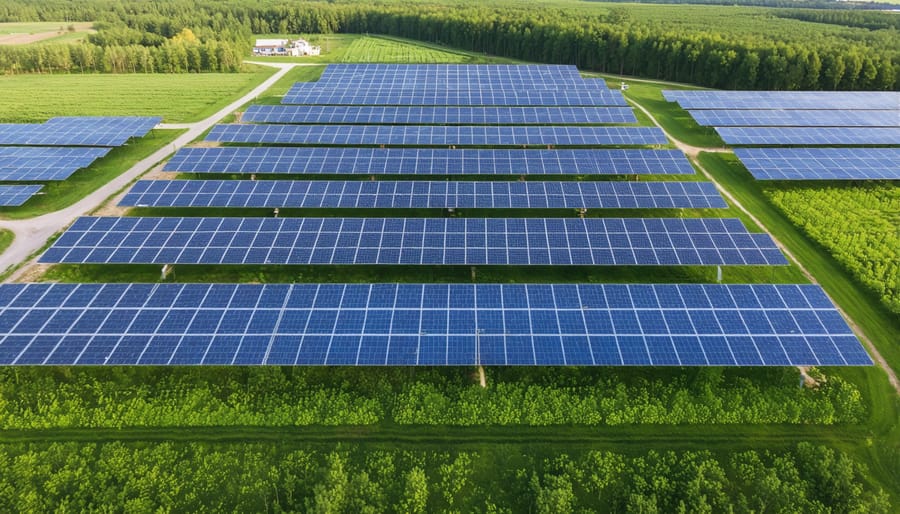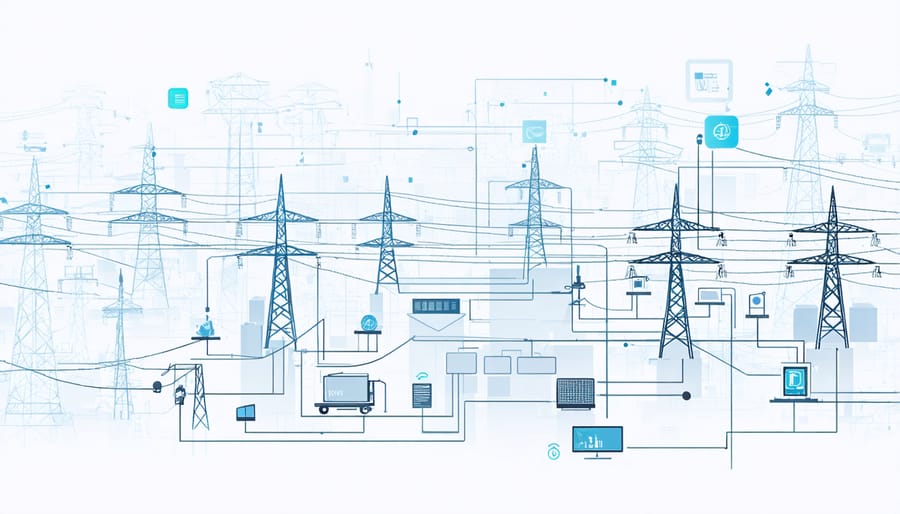As Australia’s renewable energy capacity surges past 35% of total electricity generation, the challenge of maintaining grid stability has moved from a theoretical concern to an urgent priority. The intermittent nature of wind and solar power, coupled with our vast geographical spread, presents unique challenges to our national electricity infrastructure. Yet these challenges are driving remarkable innovations in energy storage, smart grid technologies, and demand response systems.
From South Australia’s groundbreaking virtual power plant to Queensland’s renewable energy zones, Australian engineers and energy experts are pioneering solutions that are being studied globally. The integration of battery storage systems, including the world-famous Hornsdale Power Reserve, demonstrates how technical hurdles can be transformed into opportunities for grid resilience.
This evolution of our power grid isn’t just about maintaining reliability – it’s about creating a more responsive, resilient energy system capable of powering Australia’s future. While the transition presents complex technical challenges, our experience shows that with strategic planning, technological innovation, and collaborative approaches, grid stability and renewable energy can work in powerful harmony.
The key lies in understanding these challenges not as roadblocks, but as catalysts for developing a more sophisticated, flexible power system that will serve as the backbone of Australia’s clean energy future.
The Grid Stability Challenge
Variable Power Generation
One of the primary challenges facing renewable energy integration is the inherent variability of natural resources. Unlike traditional power plants that can operate consistently around the clock, renewable energy sources depend on weather conditions that aren’t always predictable. Solar panels generate electricity only during daylight hours and produce less power on cloudy days, while wind turbines require specific wind speeds to operate efficiently.
This variability creates unique challenges for grid operators who must maintain a constant balance between power supply and demand. The good news is that smart solutions are emerging to address these challenges. Combining wind and solar power helps smooth out generation patterns, as wind often blows strongest at night when solar isn’t available. Additionally, strategic placement of renewable installations across different geographic locations helps reduce the impact of localised weather conditions.
Australian grid operators are adapting to these challenges by implementing advanced forecasting systems and developing more sophisticated grid management techniques, proving that variable power generation, while complex, is entirely manageable with the right approach and technology.

Grid Frequency Management
Maintaining a stable grid frequency of 50 Hz is like conducting a massive orchestra where every instrument must play in perfect harmony. As more renewable energy sources join our power grid, this delicate balance becomes increasingly complex. Wind and solar power, while invaluable for our clean energy future, naturally fluctuate with weather conditions, creating unique challenges for grid operators.
Traditional power plants, with their spinning turbines, naturally help maintain frequency through their mechanical inertia. However, solar panels and wind turbines connect to the grid through electronic inverters, which don’t provide the same stabilising effect. This has led to innovative solutions across Australia, such as the installation of synchronous condensers in South Australia and the development of “virtual inertia” systems.
Grid operators are rising to meet these challenges with cutting-edge technology and smart management systems. For instance, battery storage systems can now respond to frequency changes in milliseconds, helping to maintain stability. The successful integration of the Hornsdale Power Reserve in South Australia demonstrates how modern technology can effectively manage these frequency challenges while supporting higher levels of renewable energy in our grid.
Bioenergy’s Role in Grid Stabilization
Dispatchable Power
Unlike solar and wind power which depend on weather conditions, bioenergy’s grid stabilization potential lies in its ability to provide power on demand. This distinctive quality makes it a valuable player in maintaining grid stability, particularly during peak usage periods or when other renewable sources are unavailable.
Think of bioenergy as nature’s battery – it stores energy in organic materials until needed. Whether it’s agricultural waste, forestry residues, or purposely grown energy crops, these feedstocks can be converted into power whenever required. This flexibility is particularly crucial for Australia’s diverse energy landscape, where remote communities often need reliable power sources independent of weather conditions.
For instance, the Berrybank Bioenergy Facility in Victoria demonstrates how agricultural waste can be transformed into steady, reliable power. The facility processes locally sourced organic materials to generate electricity 24/7, providing consistent support to the regional grid. This predictable power generation helps smooth out the intermittency issues commonly associated with renewable energy sources.
By incorporating bioenergy into our renewable energy mix, we’re essentially adding a reliable backup singer to the renewable energy choir – always ready to step in and maintain the harmony of our power supply. This dispatchable nature of bioenergy makes it an invaluable tool in Australia’s transition to a more stable, renewable energy future.

Hybrid Systems
In the ever-evolving landscape of renewable energy, hybrid systems have emerged as a game-changing solution for maintaining grid stability. By combining bioenergy with other renewable sources like solar and wind, these integrated systems create a more reliable and resilient power supply.
The Sunshine Coast’s hybrid facility serves as a brilliant example, where a biomass plant works in tandem with solar arrays to provide consistent power output. During cloudy periods or after sunset, the biomass component kicks in to maintain steady electricity generation, effectively addressing the intermittency issues common to solar power alone.
These hybrid arrangements offer multiple advantages. The bioenergy component, using agricultural waste and sustainable forestry residues, provides a predictable baseload power that complements the variable nature of wind and solar. This predictability helps grid operators maintain system frequency and voltage levels, crucial factors in power quality management.
Western Australia’s remote communities have particularly benefited from hybrid systems. Several outback towns now combine solar installations with biogas generators, reducing diesel dependency while ensuring 24/7 power availability. These systems have demonstrated remarkable stability, with some locations reporting up to 99.9% reliability rates.
The key to success lies in sophisticated control systems that orchestrate the different energy sources. Modern hybrid facilities use smart technologies to seamlessly switch between power sources, maintaining optimal grid frequency and minimizing disruptions.
Australian Success Stories
Regional Microgrids
Remote Australian communities are leading the way in demonstrating how regional microgrids can effectively manage renewable energy integration. The township of Coober Pedy in South Australia stands as a shining example, with its hybrid system combining solar, wind, and battery storage providing reliable power to 3,500 residents while reducing diesel consumption by 70%.
On the west coast, the remote mining town of Agnew showcases how industrial operations can thrive on renewable energy. Their microgrid system, incorporating solar, wind, and battery storage, powers critical mining operations with 50-60% renewable energy penetration, proving that even energy-intensive industries can operate reliably on clean power.
The success of King Island’s hybrid power system offers another compelling case study. This Bass Strait community has achieved up to 100% renewable energy penetration during favorable conditions, using a combination of wind, solar, and battery storage, supported by smart grid technology that automatically manages supply and demand.
These regional microgrids demonstrate key strategies for maintaining stability, including advanced battery storage systems, sophisticated control technologies, and careful load management. The experience gained from these projects provides valuable insights for larger grid networks, showing how renewable energy can be successfully integrated while maintaining reliable power supply, even in challenging environments.
These success stories from remote Australia are now serving as blueprints for communities worldwide looking to transition to stable, renewable energy systems.
Large-Scale Integration
Several major cities worldwide have successfully demonstrated how to manage grid stability with high renewable energy penetration. Copenhagen stands as a shining example, with its intelligent grid management system integrating wind power to provide over 40% of its electricity needs while maintaining exceptional reliability. The city’s success stems from its advanced forecasting systems and strategic energy storage solutions.
In Australia, Adelaide has emerged as a pioneer in renewable integration, effectively managing solar penetration rates of over 30% through innovative demand response programs and virtual power plants. The city’s smart grid infrastructure allows for real-time monitoring and adjustment of power flows, ensuring stability even during peak solar generation periods.
Melbourne’s approach combines rooftop solar with battery storage systems, creating a distributed network that enhances grid resilience. The city’s utilities have implemented sophisticated control systems that can respond to supply fluctuations within milliseconds, maintaining frequency stability across the network.
Internationally, Berlin’s experience shows how proper planning and investment in grid infrastructure can support massive renewable integration. The city’s implementation of dynamic grid management tools and strategic placement of energy storage facilities has enabled it to handle variable renewable energy sources while maintaining power quality standards.
These success stories demonstrate that with proper planning, technology, and investment, large-scale renewable integration is not just possible but can enhance grid reliability and stability.
Future Solutions
Smart Grid Technologies
Smart grid technologies are revolutionising how Australia manages its power distribution networks, offering innovative solutions to renewable energy integration challenges. These advanced systems combine real-time monitoring, artificial intelligence, and automated controls to create a more responsive and efficient grid infrastructure.
At the heart of these innovative renewable technologies are sophisticated sensors and communication networks that provide grid operators with instant feedback on power flow, voltage levels, and system stability. This real-time data enables quick responses to fluctuations in renewable energy generation, helping maintain consistent power supply even when weather conditions change.
Australian utilities are implementing smart inverters and advanced power electronics that automatically adjust to grid conditions, smoothing out voltage variations and maintaining power quality. These systems work like traffic controllers for electricity, directing power flows where they’re needed most and preventing grid congestion.
Digital twin technology is another game-changer, allowing operators to simulate grid behaviour and test responses to various scenarios before implementing changes in the real world. This proactive approach helps prevent potential issues and optimises grid performance, making our renewable energy future more reliable and achievable.

Energy Storage Innovation
The landscape of energy storage solutions is rapidly evolving, offering promising answers to grid stability challenges. Australia is leading the charge with innovative storage technologies, from advanced battery systems to pumped hydro installations. The Hornsdale Power Reserve in South Australia, fondly known as the “Big Battery,” has already proven its worth by responding to grid fluctuations in milliseconds, preventing potential blackouts and saving millions in grid stabilisation costs.
Beyond traditional lithium-ion batteries, emerging technologies like flow batteries and hydrogen storage are gaining traction. These systems offer longer duration storage capabilities, crucial for managing seasonal variations in renewable energy generation. Community-scale batteries are also becoming popular, with neighbourhoods sharing storage facilities to better manage their solar generation and reduce strain on the grid.
The future looks particularly bright with thermal energy storage systems, which use molten salt or other materials to store excess solar energy as heat, providing a cost-effective solution for round-the-clock power supply. These innovations are transforming how we think about grid stability, making a 100% renewable grid not just possible, but increasingly practical.
The journey toward a renewable energy future presents both challenges and opportunities for Australia’s power grid. While grid stability issues have been a significant concern, the innovative solutions being developed and implemented across the country demonstrate our ability to overcome these hurdles. Through a combination of advanced energy storage systems, smart grid technologies, and improved forecasting methods, we’re creating a more resilient and adaptable power network.
The success stories from South Australia’s virtual power plants and Western Australia’s standalone power systems show that with proper planning and investment, renewable energy can provide reliable power while maintaining grid stability. These achievements are setting benchmarks for other regions and proving that a sustainable energy future is within reach.
Looking ahead, the continued development of battery technology, hybrid systems, and grid management solutions promises even greater stability for renewable energy integration. With increasing investment in research and infrastructure, alongside supportive policies and community engagement, Australia is well-positioned to lead the way in sustainable power generation.
The key to success lies in maintaining a balanced approach: embracing innovation while ensuring reliability, supporting new technologies while strengthening existing infrastructure, and most importantly, keeping our focus on the end goal of a clean, stable, and sustainable energy future. As we continue to refine our approaches and learn from experience, the path to 100% renewable energy becomes clearer and more achievable with each passing day.

